Deck 25: Circulation
Question
Question
Question
Question
Question
Question
Question
Question
Question
Question
Question
Question
Question
Question
Question
Question
Question
Question
Question
Question
Question
Question
Question
Question
Question
Question
Question
Question
Question
Question
Question
Question
Question
Question
Question
Question
Question
Question
Question
Question
Question
Question
Question
Question
Question
Question
Question
Question
Question
Question
Question
Question
Question
Question
Question
Question
Question
Question
Question
Question
Question
Question
Question
Question
Question
Question
Question
Question
Question
Question
Question
Question

Unlock Deck
Sign up to unlock the cards in this deck!
Unlock Deck
Unlock Deck
1/72
Play
Full screen (f)
Deck 25: Circulation
1
_______ is delivered to muscle via the circulation to support exercise.
A) Oxygen
B) ATP
C) CO2
D) Blood
A) Oxygen
B) ATP
C) CO2
D) Blood
A
2
Which concept(s) regarding circulation was(were) not part of the 18th century knowledge base?
I) Tissue blood flow
II) Round trip flow in major vessels
III) Blood transport O2 to tissues
IV) Existence of capillaries
V) Hormones are transported in blood
A) I, II, and III
B) III and V
C) V
D) III
I) Tissue blood flow
II) Round trip flow in major vessels
III) Blood transport O2 to tissues
IV) Existence of capillaries
V) Hormones are transported in blood
A) I, II, and III
B) III and V
C) V
D) III
B
3
The most urgent function performed by circulation is
A) the transport of ATP.
B) the transport of hormones.
C) the transport of oxygen.
D) thermoregulatory control.
A) the transport of ATP.
B) the transport of hormones.
C) the transport of oxygen.
D) thermoregulatory control.
C
4
Which is the correct sequence of blood movement through the human heart?
A) Vena cavae → left atrium → left ventricle → pulmonary artery → pulmonary vein → right atrium → right ventricle → aorta
B) Vena cavae → right atrium → right ventricle → pulmonary artery → pulmonary vein → left atrium → left ventricle → aorta
C) Vena cavae → right atrium → right ventricle → pulmonary vein → pulmonary artery → left atrium → left ventricle → aorta
D) Aorta → left atrium → left ventricle → pulmonary artery → pulmonary vein → right atrium → right ventricle → vena cavae
A) Vena cavae → left atrium → left ventricle → pulmonary artery → pulmonary vein → right atrium → right ventricle → aorta
B) Vena cavae → right atrium → right ventricle → pulmonary artery → pulmonary vein → left atrium → left ventricle → aorta
C) Vena cavae → right atrium → right ventricle → pulmonary vein → pulmonary artery → left atrium → left ventricle → aorta
D) Aorta → left atrium → left ventricle → pulmonary artery → pulmonary vein → right atrium → right ventricle → vena cavae

Unlock Deck
Unlock for access to all 72 flashcards in this deck.
Unlock Deck
k this deck
5
Refer to the figure shown.
 Which area(s) contain oxygenated blood?
Which area(s) contain oxygenated blood?
A) I, II, and III
B) IV and V
C) IV only
D) III only
 Which area(s) contain oxygenated blood?
Which area(s) contain oxygenated blood?A) I, II, and III
B) IV and V
C) IV only
D) III only

Unlock Deck
Unlock for access to all 72 flashcards in this deck.
Unlock Deck
k this deck
6
Refer to the figure shown.
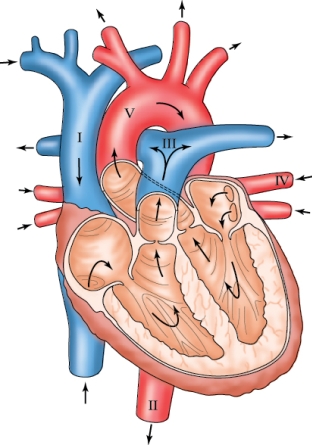 Which area refers to the pulmonary artery?
Which area refers to the pulmonary artery?
A) II
B) III
C) IV
D) V
 Which area refers to the pulmonary artery?
Which area refers to the pulmonary artery?A) II
B) III
C) IV
D) V

Unlock Deck
Unlock for access to all 72 flashcards in this deck.
Unlock Deck
k this deck
7
Refer to the figure shown.
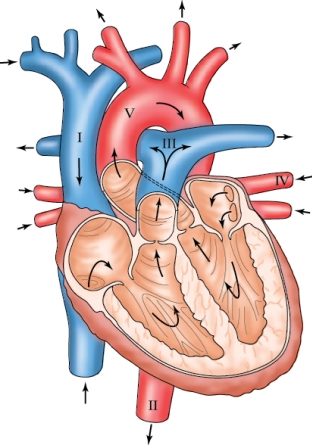 How many labeled areas refer to arteries?
How many labeled areas refer to arteries?
A) 2
B) 3
C) 4
D) 5
 How many labeled areas refer to arteries?
How many labeled areas refer to arteries?A) 2
B) 3
C) 4
D) 5

Unlock Deck
Unlock for access to all 72 flashcards in this deck.
Unlock Deck
k this deck
8
Refer to the figure shown.
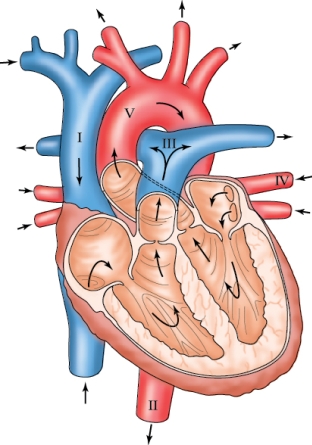 What is the order of blood flow?
What is the order of blood flow?
A) I → II → III → IV → V
B) I → V → IV → III → II
C) I → III → IV → V → II
D) IV → V → I → III → II
 What is the order of blood flow?
What is the order of blood flow?A) I → II → III → IV → V
B) I → V → IV → III → II
C) I → III → IV → V → II
D) IV → V → I → III → II

Unlock Deck
Unlock for access to all 72 flashcards in this deck.
Unlock Deck
k this deck
9
Which statement regarding cardiac output is true?
A) It is independent of stroke volume.
B) It is the product of heart rate and stroke volume.
C) It is the heart rate divided by stroke volume.
D) It is the product of heart rate and blood pressure.
A) It is independent of stroke volume.
B) It is the product of heart rate and stroke volume.
C) It is the heart rate divided by stroke volume.
D) It is the product of heart rate and blood pressure.

Unlock Deck
Unlock for access to all 72 flashcards in this deck.
Unlock Deck
k this deck
10
Refer to the figure shown.
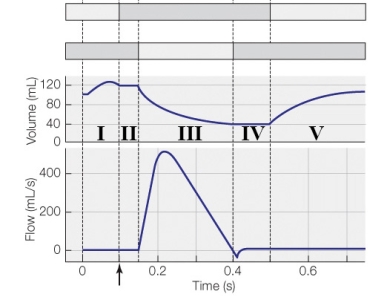 Which region represents the isovolumetric contraction portion of the heart cycle?
Which region represents the isovolumetric contraction portion of the heart cycle?
A) I
B) II
C) III
D) IV
 Which region represents the isovolumetric contraction portion of the heart cycle?
Which region represents the isovolumetric contraction portion of the heart cycle?A) I
B) II
C) III
D) IV

Unlock Deck
Unlock for access to all 72 flashcards in this deck.
Unlock Deck
k this deck
11
Refer to the figure shown.
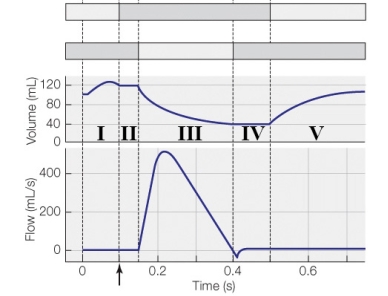 Which region represents the ventricular filling portion of the heart cycle?
Which region represents the ventricular filling portion of the heart cycle?
A) II
B) III
C) IV
D) V
 Which region represents the ventricular filling portion of the heart cycle?
Which region represents the ventricular filling portion of the heart cycle?A) II
B) III
C) IV
D) V

Unlock Deck
Unlock for access to all 72 flashcards in this deck.
Unlock Deck
k this deck
12
The myocardium of tunas is
A) composed of an outer compact layer with coronary vessels and an inner spongy layer.
B) spongy, with little or no development of coronary vessels.
C) compact, with coronary arteries and veins.
D) a mixed structure, with blood flowing from lumen into coronary veins.
A) composed of an outer compact layer with coronary vessels and an inner spongy layer.
B) spongy, with little or no development of coronary vessels.
C) compact, with coronary arteries and veins.
D) a mixed structure, with blood flowing from lumen into coronary veins.

Unlock Deck
Unlock for access to all 72 flashcards in this deck.
Unlock Deck
k this deck
13
Most crustaceans have _______ hearts.
A) myogenic
B) neurogenic
C) hemogenic
D) non innervated
A) myogenic
B) neurogenic
C) hemogenic
D) non innervated

Unlock Deck
Unlock for access to all 72 flashcards in this deck.
Unlock Deck
k this deck
14
The _______ prevents the initial depolarization at the S-A node from spreading across the heart from the atria through the ventricles and ending at the tip of the septum.
A) S-A node
B) connective tissue between the atria and ventricles
C) interventricular septum
D) bundle of Purkinje fibers
A) S-A node
B) connective tissue between the atria and ventricles
C) interventricular septum
D) bundle of Purkinje fibers

Unlock Deck
Unlock for access to all 72 flashcards in this deck.
Unlock Deck
k this deck
15
The pacemaker of a lobster heart is composed of
A) specialized myocardium that functions in a manner similar to the S-A node.
B) specialized myocardium that functions as a central pattern generator.
C) a series of neurons connected to and controlled by the brain.
D) a posterior cardiac neuron that functions as a cellular oscillator and central pattern generator.
A) specialized myocardium that functions in a manner similar to the S-A node.
B) specialized myocardium that functions as a central pattern generator.
C) a series of neurons connected to and controlled by the brain.
D) a posterior cardiac neuron that functions as a cellular oscillator and central pattern generator.

Unlock Deck
Unlock for access to all 72 flashcards in this deck.
Unlock Deck
k this deck
16
Which statement describes the Frank-Starling mechanism?
A) An increase in the filling time of the ventricles increases the contraction pressure.
B) Increasing flow from the heart increases arterial pressure.
C) Increasing pressure in the heart increases outflow.
D) Stretching of the cardiac muscle increases the force of its contraction at the cellular level.
A) An increase in the filling time of the ventricles increases the contraction pressure.
B) Increasing flow from the heart increases arterial pressure.
C) Increasing pressure in the heart increases outflow.
D) Stretching of the cardiac muscle increases the force of its contraction at the cellular level.

Unlock Deck
Unlock for access to all 72 flashcards in this deck.
Unlock Deck
k this deck
17
A neurogenic heart and a myogenic heart both have all the neurons attached to it removed. Which of the following is an accurate representation of the result?
A) The neurogenic heart will continue to beat whereas the myogenic heart will cease to beat.
B) The neurogenic heart will cease to beat whereas the myogenic heart will continue to beat.
C) Both hearts will continue to beat, but at different rates.
D) Both hearts will cease to beat.
A) The neurogenic heart will continue to beat whereas the myogenic heart will cease to beat.
B) The neurogenic heart will cease to beat whereas the myogenic heart will continue to beat.
C) Both hearts will continue to beat, but at different rates.
D) Both hearts will cease to beat.

Unlock Deck
Unlock for access to all 72 flashcards in this deck.
Unlock Deck
k this deck
18
The P wave of the EKG is produced by the
A) contraction of the atria.
B) contraction of the ventricles.
C) depolarization of the atria.
D) repolarization of the atria.
A) contraction of the atria.
B) contraction of the ventricles.
C) depolarization of the atria.
D) repolarization of the atria.

Unlock Deck
Unlock for access to all 72 flashcards in this deck.
Unlock Deck
k this deck
19
ECG (EKG) electrodes are placed _______ and measures _______.
A) under the skin; voltage differences in the heart muscle
B) under the skin; heart contraction and relaxation
C) on the skin; voltage differences in the heart muscle
D) on the skin; heart contraction and relaxation
A) under the skin; voltage differences in the heart muscle
B) under the skin; heart contraction and relaxation
C) on the skin; voltage differences in the heart muscle
D) on the skin; heart contraction and relaxation

Unlock Deck
Unlock for access to all 72 flashcards in this deck.
Unlock Deck
k this deck
20
Which of the following are considered functional properties of the cardiac conduction system?
I) Initiate cardiac contraction
II) Accelerate depolarization across the atria
III) Slows the depolarization across the A-V node
IV) Accelerates depolarization down the bundle branches and Purkinje fibers
A) I and II
B) III and IV
C) II, III, and IV
D) I, II, III, and IV
I) Initiate cardiac contraction
II) Accelerate depolarization across the atria
III) Slows the depolarization across the A-V node
IV) Accelerates depolarization down the bundle branches and Purkinje fibers
A) I and II
B) III and IV
C) II, III, and IV
D) I, II, III, and IV

Unlock Deck
Unlock for access to all 72 flashcards in this deck.
Unlock Deck
k this deck
21
The mean pressure in the systemic aorta in a healthy human is about _______ mm Hg.
A) 120
B) 95
C) 75
D) 50
A) 120
B) 95
C) 75
D) 50

Unlock Deck
Unlock for access to all 72 flashcards in this deck.
Unlock Deck
k this deck
22
A tall human with normal blood pressure standing upright would be expected to have a pressure of about _______ mm Hg in the leg artery, measured 130 cm shown the heart.
A) 95
B) 120
C) 150
D) 195
A) 95
B) 120
C) 150
D) 195

Unlock Deck
Unlock for access to all 72 flashcards in this deck.
Unlock Deck
k this deck
23
According to the Poiseuille equation, which of the following does not directly affect flow rate?
A) Temperature of the tube
B) Viscosity of the fluid
C) Radius of the lumen of the tube
D) Pressure at the entry of the tube
A) Temperature of the tube
B) Viscosity of the fluid
C) Radius of the lumen of the tube
D) Pressure at the entry of the tube

Unlock Deck
Unlock for access to all 72 flashcards in this deck.
Unlock Deck
k this deck
24
Halving the radius of a vessel _______ the resistance to flow through the vessel by a factor of _______.
A) decreases; 4
B) decreases; 16
C) increases; 4
D) increases; 16
A) decreases; 4
B) decreases; 16
C) increases; 4
D) increases; 16

Unlock Deck
Unlock for access to all 72 flashcards in this deck.
Unlock Deck
k this deck
25
The most important factor modifying flow in blood vessels is the
A) pressure in the vessel.
B) diameter of the vessel.
C) viscosity of fluid in the vessel.
D) length of the vessel.
A) pressure in the vessel.
B) diameter of the vessel.
C) viscosity of fluid in the vessel.
D) length of the vessel.

Unlock Deck
Unlock for access to all 72 flashcards in this deck.
Unlock Deck
k this deck
26
The reason why blood capillaries can be exceedingly thin-walled and yet resist substantial pressures can be explained by
A) Laplace's law.
B) Poiseuille's equation.
C) Hagen's equation.
D) Fick's law.
A) Laplace's law.
B) Poiseuille's equation.
C) Hagen's equation.
D) Fick's law.

Unlock Deck
Unlock for access to all 72 flashcards in this deck.
Unlock Deck
k this deck
27
You are measuring the blood pressure (using a standard cuff on the brachial artery) of a patient who insists on holding her arm above her head while you are taking the measurement. How to you deal with the data you collect.
A) As long are you are careful, the data you collect are valid.
B) The measurement in the raised arm will overestimate the actual blood pressure.
C) The measurement in the raised arm will underestimate the actual blood pressure.
D) The pressure measurement will be accurate, but the heart rate measurement will not.
A) As long are you are careful, the data you collect are valid.
B) The measurement in the raised arm will overestimate the actual blood pressure.
C) The measurement in the raised arm will underestimate the actual blood pressure.
D) The pressure measurement will be accurate, but the heart rate measurement will not.

Unlock Deck
Unlock for access to all 72 flashcards in this deck.
Unlock Deck
k this deck
28
The main difference between the pulmonary circuit and the systemic circuit is that the pulmonary circuit
A) has a higher resistance.
B) produces lower pressures.
C) produces lower flows.
D) has a lower cardiac output.
A) has a higher resistance.
B) produces lower pressures.
C) produces lower flows.
D) has a lower cardiac output.

Unlock Deck
Unlock for access to all 72 flashcards in this deck.
Unlock Deck
k this deck
29
Which statement regarding microcirculatory beds is true?
A) Smooth muscles in the walls of arterioles are responsible for vasoconstriction and vasodilation.
B) Anastomoses are the one possible path from an arteriole to a venule.
C) The walls of capillaries consist of vascular endothelium and a smooth muscle layer.
D) Venules and arterioles are the preeminent sites of O2 and water exchange.
A) Smooth muscles in the walls of arterioles are responsible for vasoconstriction and vasodilation.
B) Anastomoses are the one possible path from an arteriole to a venule.
C) The walls of capillaries consist of vascular endothelium and a smooth muscle layer.
D) Venules and arterioles are the preeminent sites of O2 and water exchange.

Unlock Deck
Unlock for access to all 72 flashcards in this deck.
Unlock Deck
k this deck
30
Place the patients in order from lowest to highest vascular resistance.
Patient 1) Blood pressure = 120/80 mm Hg; cardiac output 4 L/min
Patient 2) Blood pressure = 140/100 mm Hg; cardiac output 5 L/min
Patient 3) Blood pressure = 100/60 mm Hg; cardiac output 5 L/min
A) Patient 1, Patient 2, Patient 3
B) Patient 3, Patient 2, Patient 1
C) Patient 2, Patient 1, Patient 3
D) Patient 3, Patient 1, Patient 2
Patient 1) Blood pressure = 120/80 mm Hg; cardiac output 4 L/min
Patient 2) Blood pressure = 140/100 mm Hg; cardiac output 5 L/min
Patient 3) Blood pressure = 100/60 mm Hg; cardiac output 5 L/min
A) Patient 1, Patient 2, Patient 3
B) Patient 3, Patient 2, Patient 1
C) Patient 2, Patient 1, Patient 3
D) Patient 3, Patient 1, Patient 2

Unlock Deck
Unlock for access to all 72 flashcards in this deck.
Unlock Deck
k this deck
31
Refer to the figure shown.
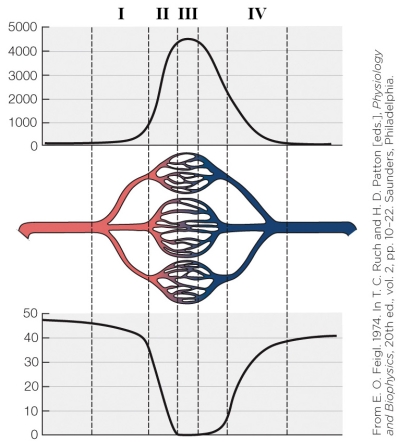 Which vertical section denotes the vascular portion with the highest pressure?
Which vertical section denotes the vascular portion with the highest pressure?
A) I
B) II
C) III
D) IV
 Which vertical section denotes the vascular portion with the highest pressure?
Which vertical section denotes the vascular portion with the highest pressure?A) I
B) II
C) III
D) IV

Unlock Deck
Unlock for access to all 72 flashcards in this deck.
Unlock Deck
k this deck
32
Refer to the figure shown.
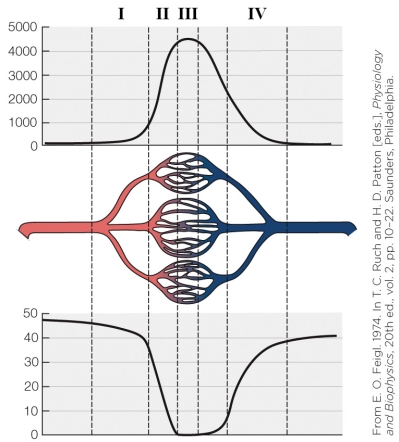 Which vertical section denotes the vascular portion with the lowest mean blood velocity?
Which vertical section denotes the vascular portion with the lowest mean blood velocity?
A) I
B) II
C) III
D) IV
 Which vertical section denotes the vascular portion with the lowest mean blood velocity?
Which vertical section denotes the vascular portion with the lowest mean blood velocity?A) I
B) II
C) III
D) IV

Unlock Deck
Unlock for access to all 72 flashcards in this deck.
Unlock Deck
k this deck
33
Refer to the figure shown.
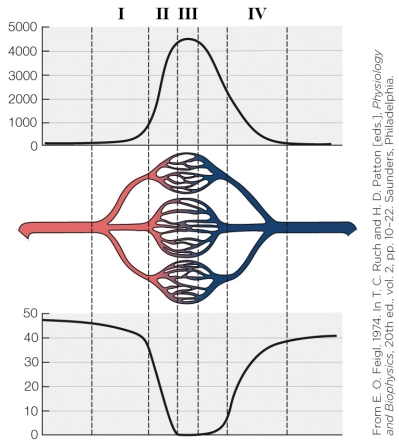 Which vertical section denotes the vascular portion with the highest vascular resistance?
Which vertical section denotes the vascular portion with the highest vascular resistance?
A) I
B) II
C) III
D) IV
 Which vertical section denotes the vascular portion with the highest vascular resistance?
Which vertical section denotes the vascular portion with the highest vascular resistance?A) I
B) II
C) III
D) IV

Unlock Deck
Unlock for access to all 72 flashcards in this deck.
Unlock Deck
k this deck
34
Refer to the figure shown.
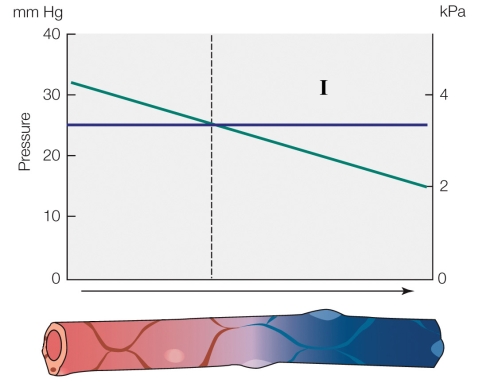 In section I, fluid is _______ the capillary due to _______.
In section I, fluid is _______ the capillary due to _______.
A) leaking out of; hydrostatic pressure
B) leaking out of; colloid osmotic pressure
C) moving into; hydrostatic pressure
D) moving into; colloid osmotic pressure
 In section I, fluid is _______ the capillary due to _______.
In section I, fluid is _______ the capillary due to _______.A) leaking out of; hydrostatic pressure
B) leaking out of; colloid osmotic pressure
C) moving into; hydrostatic pressure
D) moving into; colloid osmotic pressure

Unlock Deck
Unlock for access to all 72 flashcards in this deck.
Unlock Deck
k this deck
35
Refer to the figure shown.
 The figure depicts the _______ hypothesis: the initial loss and then regaining of fluid in the capillaries that results, overall, in a net _______ of fluid.
The figure depicts the _______ hypothesis: the initial loss and then regaining of fluid in the capillaries that results, overall, in a net _______ of fluid.
A) Frank‒Starling; loss
B) Starling‒Landis; loss
C) Frank‒Landis; gain
D) Poiseuille; gain
 The figure depicts the _______ hypothesis: the initial loss and then regaining of fluid in the capillaries that results, overall, in a net _______ of fluid.
The figure depicts the _______ hypothesis: the initial loss and then regaining of fluid in the capillaries that results, overall, in a net _______ of fluid.A) Frank‒Starling; loss
B) Starling‒Landis; loss
C) Frank‒Landis; gain
D) Poiseuille; gain

Unlock Deck
Unlock for access to all 72 flashcards in this deck.
Unlock Deck
k this deck
36
Which of the following best describes the contractile properties of the heart of the elasmobranch fish?
A) There are four chambers, however only the atria and ventricle contract.
B) There are only two chambers, an atria and a ventricle, and they both contract.
C) There are four chambers, and three contract.
D) There are four chambers, and all four contract.
A) There are four chambers, however only the atria and ventricle contract.
B) There are only two chambers, an atria and a ventricle, and they both contract.
C) There are four chambers, and three contract.
D) There are four chambers, and all four contract.

Unlock Deck
Unlock for access to all 72 flashcards in this deck.
Unlock Deck
k this deck
37
Which characteristic is typical of teleost cardiovascular systems?
A) The heart receives oxygenated blood flowing from the gills.
B) Cardiac outputs are lower than those of similar-sized mammals.
C) Blood pressure increases significantly as blood passes through the gills.
D) Arterial pressures are higher than those of similar-sized mammals.
A) The heart receives oxygenated blood flowing from the gills.
B) Cardiac outputs are lower than those of similar-sized mammals.
C) Blood pressure increases significantly as blood passes through the gills.
D) Arterial pressures are higher than those of similar-sized mammals.

Unlock Deck
Unlock for access to all 72 flashcards in this deck.
Unlock Deck
k this deck
38
Refer to the figure shown.
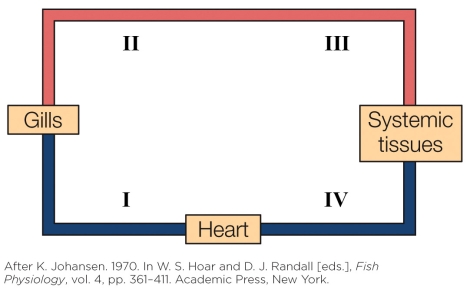 From where do vessels branch off to supply the head and gut with oxygenated blood?
From where do vessels branch off to supply the head and gut with oxygenated blood?
A) I
B) II
C) III
D) IV
 From where do vessels branch off to supply the head and gut with oxygenated blood?
From where do vessels branch off to supply the head and gut with oxygenated blood?A) I
B) II
C) III
D) IV

Unlock Deck
Unlock for access to all 72 flashcards in this deck.
Unlock Deck
k this deck
39
Refer to the figure shown.
 When an air-breathing organ at the mouth is integrated into the circulation depicted in the figure, a new circulation loop is created connecting
When an air-breathing organ at the mouth is integrated into the circulation depicted in the figure, a new circulation loop is created connecting
A) I to III.
B) II to III.
C) I to IV.
D) III to IV.
 When an air-breathing organ at the mouth is integrated into the circulation depicted in the figure, a new circulation loop is created connecting
When an air-breathing organ at the mouth is integrated into the circulation depicted in the figure, a new circulation loop is created connectingA) I to III.
B) II to III.
C) I to IV.
D) III to IV.

Unlock Deck
Unlock for access to all 72 flashcards in this deck.
Unlock Deck
k this deck
40
In fish that have an air-breathing organ (ABO), the blood
A) leaving the ABO mixes with systemic and venous blood.
B) leaving the ABO mixes with blood leaving the gills.
C) enters the ABO following the exit from the gills.
D) leaving the ABO enters the gills.
A) leaving the ABO mixes with systemic and venous blood.
B) leaving the ABO mixes with blood leaving the gills.
C) enters the ABO following the exit from the gills.
D) leaving the ABO enters the gills.

Unlock Deck
Unlock for access to all 72 flashcards in this deck.
Unlock Deck
k this deck
41
Which statement describes a characteristic not found in the African lungfish Protopterus?
A) The ventral aorta is extremely long and branched.
B) The atrium and the ventricles are partially divided into left and right halves by septa.
C) The conus arteriosus has longitudinal ridges that divide the lumen into two channels.
D) The four pairs of branchial arteries arise immediately from the conus arteriosus.
A) The ventral aorta is extremely long and branched.
B) The atrium and the ventricles are partially divided into left and right halves by septa.
C) The conus arteriosus has longitudinal ridges that divide the lumen into two channels.
D) The four pairs of branchial arteries arise immediately from the conus arteriosus.

Unlock Deck
Unlock for access to all 72 flashcards in this deck.
Unlock Deck
k this deck
42
Fish with _______ are able to swim faster and longer due to _______.
A) compact myocardium; the coronary circulation
B) compact myocardium; greater contractile force and rate
C) spongy myocardium; the coronary circulation
D) spongy myocardium; greater contractile force and rate
A) compact myocardium; the coronary circulation
B) compact myocardium; greater contractile force and rate
C) spongy myocardium; the coronary circulation
D) spongy myocardium; greater contractile force and rate

Unlock Deck
Unlock for access to all 72 flashcards in this deck.
Unlock Deck
k this deck
43
Refer to the figure shown.
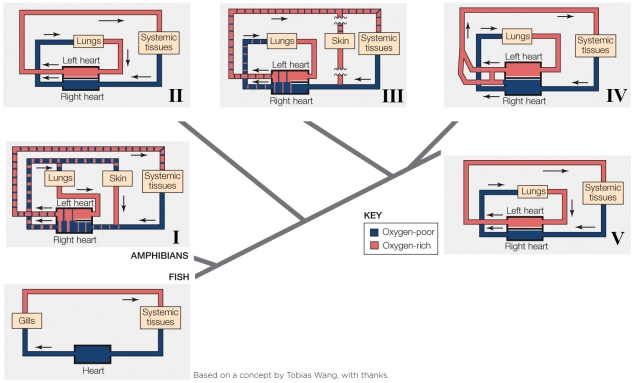 Which plan represents the mammalian circulatory system?
Which plan represents the mammalian circulatory system?
A) II
B) III
C) IV
D) V
 Which plan represents the mammalian circulatory system?
Which plan represents the mammalian circulatory system?A) II
B) III
C) IV
D) V

Unlock Deck
Unlock for access to all 72 flashcards in this deck.
Unlock Deck
k this deck
44
Refer to the figure shown.
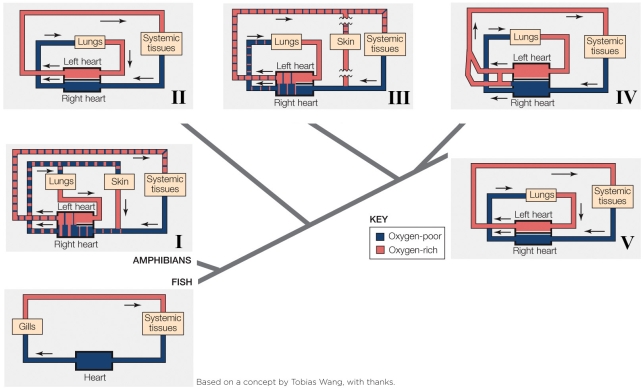 Of the six circulatory plans above, how many partially or completely separate oxygenated and deoxygenated blood in the heart?
Of the six circulatory plans above, how many partially or completely separate oxygenated and deoxygenated blood in the heart?
A) Two
B) Three
C) Four
D) Five
 Of the six circulatory plans above, how many partially or completely separate oxygenated and deoxygenated blood in the heart?
Of the six circulatory plans above, how many partially or completely separate oxygenated and deoxygenated blood in the heart?A) Two
B) Three
C) Four
D) Five

Unlock Deck
Unlock for access to all 72 flashcards in this deck.
Unlock Deck
k this deck
45
Refer to the figure shown.
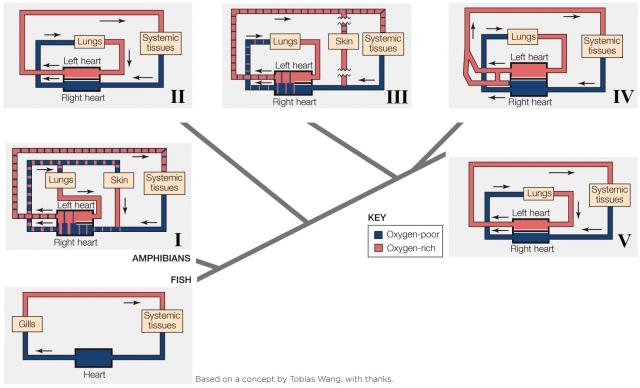 Which circulatory plan allows the animals to modulate blood flow to the lungs independently of blood flow to the rest of the body?
Which circulatory plan allows the animals to modulate blood flow to the lungs independently of blood flow to the rest of the body?
A) II and V
B) II, IV, and V
C) I, III, and IV
D) I, IV, and V
 Which circulatory plan allows the animals to modulate blood flow to the lungs independently of blood flow to the rest of the body?
Which circulatory plan allows the animals to modulate blood flow to the lungs independently of blood flow to the rest of the body?A) II and V
B) II, IV, and V
C) I, III, and IV
D) I, IV, and V

Unlock Deck
Unlock for access to all 72 flashcards in this deck.
Unlock Deck
k this deck
46
Which animal does not modulate blood flow to the lungs independently of blood flow to the rest of the body?
A) Lungfish
B) Amphibians
C) Crocodilians
D) Birds
A) Lungfish
B) Amphibians
C) Crocodilians
D) Birds

Unlock Deck
Unlock for access to all 72 flashcards in this deck.
Unlock Deck
k this deck
47
Which structure aids crocodilians in diverting blood flow during diving?
A) Foramen ovale
B) Foramen of Panizza
C) Ductus arteriosus
D) Pulmonary artery
A) Foramen ovale
B) Foramen of Panizza
C) Ductus arteriosus
D) Pulmonary artery

Unlock Deck
Unlock for access to all 72 flashcards in this deck.
Unlock Deck
k this deck
48
Which of the following is present in crocodilians but not in amphibians?
A) 2 atria
B) the ability to shunt blood
C) a ventricular septum
D) a pulmonary circulation
A) 2 atria
B) the ability to shunt blood
C) a ventricular septum
D) a pulmonary circulation

Unlock Deck
Unlock for access to all 72 flashcards in this deck.
Unlock Deck
k this deck
49
The _______ circulatory system of squids and octopuses consist of two _______.
A) open; branchial hearts and one systemic heart
B) open; systemic hearts and one branchial heart
C) closed; systemic hearts and one branchial heart
D) closed; branchial hearts and one systemic heart
A) open; branchial hearts and one systemic heart
B) open; systemic hearts and one branchial heart
C) closed; systemic hearts and one branchial heart
D) closed; branchial hearts and one systemic heart

Unlock Deck
Unlock for access to all 72 flashcards in this deck.
Unlock Deck
k this deck
50
Refer to the figure shown.
 This circulatory plan belongs to which group of animals?
This circulatory plan belongs to which group of animals?
A) Decapod crustaceans
B) Invertebrates
C) Fish
D) Cephalopod molluscs
 This circulatory plan belongs to which group of animals?
This circulatory plan belongs to which group of animals?A) Decapod crustaceans
B) Invertebrates
C) Fish
D) Cephalopod molluscs

Unlock Deck
Unlock for access to all 72 flashcards in this deck.
Unlock Deck
k this deck
51
Refer to the figure shown.
 The most oxygenated blood would be found just exiting the structure(s) at
The most oxygenated blood would be found just exiting the structure(s) at
A) I.
B) II.
C) III.
D) IV.
 The most oxygenated blood would be found just exiting the structure(s) at
The most oxygenated blood would be found just exiting the structure(s) atA) I.
B) II.
C) III.
D) IV.

Unlock Deck
Unlock for access to all 72 flashcards in this deck.
Unlock Deck
k this deck
52
Refer to the figure shown.
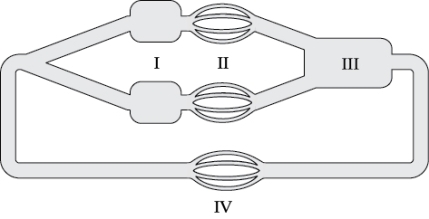 According to the diagram, the highest blood pressure would be found just exiting the structure(s) at
According to the diagram, the highest blood pressure would be found just exiting the structure(s) at
A) I.
B) II.
C) III.
D) IV.
 According to the diagram, the highest blood pressure would be found just exiting the structure(s) at
According to the diagram, the highest blood pressure would be found just exiting the structure(s) atA) I.
B) II.
C) III.
D) IV.

Unlock Deck
Unlock for access to all 72 flashcards in this deck.
Unlock Deck
k this deck
53
Which of the following are similar between an octopus heart and mammalian heart?
I) Myogenic heart
II_ Systemic heart
III) Respiratory pump
IV) Pressure from systemic heart around 120 mm Hg
A) I and II
B) I, II, and III
C) I, III, and IV
D) I, II, III, and IV
I) Myogenic heart
II_ Systemic heart
III) Respiratory pump
IV) Pressure from systemic heart around 120 mm Hg
A) I and II
B) I, II, and III
C) I, III, and IV
D) I, II, III, and IV

Unlock Deck
Unlock for access to all 72 flashcards in this deck.
Unlock Deck
k this deck
54
A squid meets the increased demand for O2 at the tissues during intense exercise by
A) increasing its circulation rate.
B) pulling more O2 from the blood.
C) both increasing circulation rate and pulling more O2 from the blood.
D) making use of anaerobic metabolism only.
A) increasing its circulation rate.
B) pulling more O2 from the blood.
C) both increasing circulation rate and pulling more O2 from the blood.
D) making use of anaerobic metabolism only.

Unlock Deck
Unlock for access to all 72 flashcards in this deck.
Unlock Deck
k this deck
55
If a squid and a fish both double cardiac output during exercise, circulatory oxygen delivery to the tissues in _______ will _______.
A) both animals; remain the same
B) both animals; double
C) the fish; be higher than in the squid
D) the squid; be higher than in the fish
A) both animals; remain the same
B) both animals; double
C) the fish; be higher than in the squid
D) the squid; be higher than in the fish

Unlock Deck
Unlock for access to all 72 flashcards in this deck.
Unlock Deck
k this deck
56
Small spaces among cells of nonvascular organs and tissues are called
A) lacunae.
B) sinuses.
C) ostia.
D) interstitial.
A) lacunae.
B) sinuses.
C) ostia.
D) interstitial.

Unlock Deck
Unlock for access to all 72 flashcards in this deck.
Unlock Deck
k this deck
57
Refer to the figure shown.
 This circulatory plan belongs to which group of animals?
This circulatory plan belongs to which group of animals?
A) Cephalopod molluscs
B) Invertebrates
C) Fish
D) Decapod crustaceans
 This circulatory plan belongs to which group of animals?
This circulatory plan belongs to which group of animals?A) Cephalopod molluscs
B) Invertebrates
C) Fish
D) Decapod crustaceans

Unlock Deck
Unlock for access to all 72 flashcards in this deck.
Unlock Deck
k this deck
58
Refer to the figure shown.
 The most oxygenated blood would be found
The most oxygenated blood would be found
A) at I.
B) just exiting the structure at II.
C) at III.
D) just exiting the structure at V.
 The most oxygenated blood would be found
The most oxygenated blood would be foundA) at I.
B) just exiting the structure at II.
C) at III.
D) just exiting the structure at V.

Unlock Deck
Unlock for access to all 72 flashcards in this deck.
Unlock Deck
k this deck
59
Refer to the figure shown.
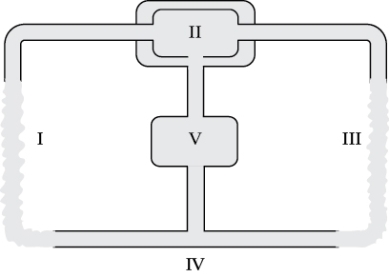 The wavy boundaries at I and III represent the
The wavy boundaries at I and III represent the
A) lack of vessels in the systemic tissues.
B) gills.
C) venous system.
D) branchio-pericardial sinuses.
 The wavy boundaries at I and III represent the
The wavy boundaries at I and III represent theA) lack of vessels in the systemic tissues.
B) gills.
C) venous system.
D) branchio-pericardial sinuses.

Unlock Deck
Unlock for access to all 72 flashcards in this deck.
Unlock Deck
k this deck
60
The blood circulation of crustaceans is _______ than that of fish primarily because of _______.
A) faster; lower resistance
B) faster; higher pressure
C) slower; lower pressure
D) slower; higher resistance
A) faster; lower resistance
B) faster; higher pressure
C) slower; lower pressure
D) slower; higher resistance

Unlock Deck
Unlock for access to all 72 flashcards in this deck.
Unlock Deck
k this deck
61
Which statement regarding the lobster circulatory system is false?
A) Hemolymph returns through holes in the heart called ostia.
B) All vessels connected to the heart are arteries.
C) The primary force that refills the heart is elastic rebound.
D) There is a clear distinction between blood and interstitial fluid.
A) Hemolymph returns through holes in the heart called ostia.
B) All vessels connected to the heart are arteries.
C) The primary force that refills the heart is elastic rebound.
D) There is a clear distinction between blood and interstitial fluid.

Unlock Deck
Unlock for access to all 72 flashcards in this deck.
Unlock Deck
k this deck
62
In lobsters and crabs, blood from the _______ collects in the _______ before passing through the gills.
A) heart; pericardial sinus
B) systemic tissues; infrabranchial sinus
C) heart; infrabranchial sinus
D) systemic tissues; pericardial sinus
A) heart; pericardial sinus
B) systemic tissues; infrabranchial sinus
C) heart; infrabranchial sinus
D) systemic tissues; pericardial sinus

Unlock Deck
Unlock for access to all 72 flashcards in this deck.
Unlock Deck
k this deck
63
Describe the four systems that have evolved in animals to supply O2 to the myocardium and name the main animal groups that use each one.

Unlock Deck
Unlock for access to all 72 flashcards in this deck.
Unlock Deck
k this deck
64
Compare and contrast the myogenic and neurogenic heart.

Unlock Deck
Unlock for access to all 72 flashcards in this deck.
Unlock Deck
k this deck
65
Why does the depolarization wave not travel across the mammalian heart from anterior to posterior (atria to ventricles) in a linear wave?

Unlock Deck
Unlock for access to all 72 flashcards in this deck.
Unlock Deck
k this deck
66
Explain, according to the physics of fluid-column effects, why a vascular foot injury needs to be elevated as much and as long as possible.

Unlock Deck
Unlock for access to all 72 flashcards in this deck.
Unlock Deck
k this deck
67
How is vascular resistance related to the Poiseuille equation?

Unlock Deck
Unlock for access to all 72 flashcards in this deck.
Unlock Deck
k this deck
68
Describe and explain the linear velocity profile of red blood cells as they travel from the heart through the systemic tissues and back.

Unlock Deck
Unlock for access to all 72 flashcards in this deck.
Unlock Deck
k this deck
69
Describe how an air-breathing organ is integrated into the circulatory plan of fish and how this physiology relates to the oxygenation of the fish myocardium.

Unlock Deck
Unlock for access to all 72 flashcards in this deck.
Unlock Deck
k this deck
70
Explain how some animals modulate blood flow to their lungs independently of flow to the rest of the body and what the advantages are to this arrangement.

Unlock Deck
Unlock for access to all 72 flashcards in this deck.
Unlock Deck
k this deck
71
Compare and contrast the mammalian and cephalopod circulatory systems.

Unlock Deck
Unlock for access to all 72 flashcards in this deck.
Unlock Deck
k this deck
72
Defend or refute this statement: "Blood flow through open systems is sluggish because of the relatively low-pressure gradients in open circulatory systems."

Unlock Deck
Unlock for access to all 72 flashcards in this deck.
Unlock Deck
k this deck



